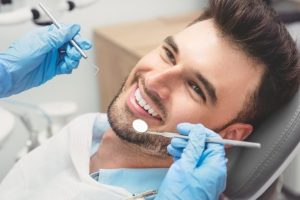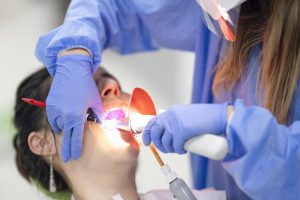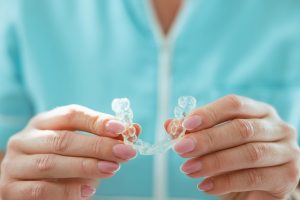
Home care is equally important to visiting the dentist twice a year. Brushing and flossing are the most important daily habits to good oral hygiene. Proper brushing and flossing not only protect the teeth and gums from disease but also reduce the bacteria that may lead to other diseases in the body.
The Benefits of Brushing
The purpose of brushing is to remove food particles from your teeth. When food decomposes in your mouth, it nourishes dangerous bacteria. These bacteria cause several unpleasant problems that lead to painful tooth decay and other serious conditions.
Proper brushing and flossing are essential for prevention of:
- Staining – Certain foods, and especially beverages such as tea, can stain your teeth.
- Bad Breath (halitosis) – Bad breath is not only unpleasant for others, but it can also indicate serious health problems.
- Decay – Bacteria break down the protective enamel on teeth, which leads to decay. Tooth decay leads to cavities, and cavities lead to infection when left untreated.
- Periodontal disease – Keeping gums healthy through regular brushing and flossing prevents periodontal disease, which can be painful and uncomfortable to treat.
The Right Way to Brush
You should plan to brush at least twice a day or after each meal. The proper toothbrush should be small with soft, rounded bristles and should ideally be changed every 3-4 months. There are also various types of electrical toothbrushes that have received The American Dental Association (ADA) seal of approval.
If you choose an electric toothbrush, focus on the area where the gums meet the teeth. Also, don’t forget to brush your tongue — a large percentage of bacteria live there.
Steps for Proper Brushing
- Place the toothbrush at a 45-degree angle against the surface of the tooth where the gums and tooth meet.
- With small circular motions gently brush the teeth and gums.
- Be careful not to apply too much pressure or scrubbing. This can damage the enamel of the teeth and the soft tissue of the gums.
Why Flossing Matters
Although your teeth may feel fresh just after you brush, food particles and bacteria remain in the small spaces between the teeth. Flossing is an additional way to prevent decay and recession by removing plaque from the spaces between the teeth. These areas are difficult to reach with traditional toothbrushes, and flossing should be done everyday. There are many types of floss on the market and selecting the right type of floss is important and should be discussed with one of our dentists.
Basic Steps for Proper Flossing
When flossing, make sure you clean the spaces between the teeth in the front and rear of your mouth. You may bleed a little at first. As you make flossing a regular habit, however, the bleeding should stop. If you continue to bleed following regular brushing and flossing, make an appointment to meet with one of our dentists.
To begin flossing, you must:
- Dispense a piece of floss approximately 18 inches long and wrap one end around the middle fingers of both hands. Continue wrapping until you can place your index finger on the floss, and they are 4-5 inches apart.
- Work the floss between the contacts of the teeth down toward the gums.
- Once the floss is past the contact, gently curve the floss around each individual tooth and move the floss up and down to remove debris.
Pre-threaded Floss
Many people have switched from traditional floss to the new pre-threaded floss holders. These convenient ways to floss make it much easier to quickly and effectively floss between each of your teeth. If you find it difficult to wrap floss around your fingers and reach your back teeth, this may be a great alternative. Should the floss become dirty, simply rinse the floss and continue — or dispose of it and use a new flosser. You can use the pick-end to carefully dislodge stubborn food particles.
Educational Video:
Frequently Asked Questions for How to Properly Brush and Floss
While most people follow the brush, then floss routine, flossing first can be much more effective in removing plaque buildup. Flossing before you brush your teeth with fluoride toothpaste can create better fluoride retention between teeth.
Likewise, any loose plaque can be brushed away rather than becoming stuck again. Along with flossing and brushing, using mouthwash makes your oral hygiene routine much more effective in removing and preventing plaque build-up.
Gently brush your teeth using small, circular motions. Always use light pressure to avoid damaging the gums or tooth enamel with harsh, abrasive brushing. Ensure you brush each tooth (front, back, and surface), gumline, inner cheeks, and tongue surface to remove plaque build-up.
In the same way, don’t place a lot of pressure as you floss in between your teeth. Carefully wiggle the floss between your teeth and avoid pressing the floss deep into your gums.
Unless you haven’t flossed in a while, your gums shouldn’t bleed after every flossing session. If they do, you’re most likely pressing too hard into your gums, causing irritation and pain.
During your oral hygiene routine, complete each step in the following order: Floss, Brush, Mouthwash.
According to the Mayo Clinic, mouthwash is best after brushing and flossing. In contrast, the National Health Service (NHS) suggests refraining from using mouthwash immediately after brushing, as doing so might remove the fluoride from toothpaste and instead use mouthwash at a different time of day.
If you are just getting into the habit of flossing, it can take up to two weeks for symptoms of gingivitis to clear up. This is considering that you’re maintaining a routine of flossing, brushing, and dental check-ups.
Rinsing immediately after you brush can wash off the fluoride that’s proactively fighting plaque and bacteria. Wait around twenty minutes before rinsing to give fluoride the time to be effective in tooth decay prevention.
You should be flossing once a day and brushing your teeth twice a day. Flossing too frequently can result in gum sensitivity and soreness. Likewise, floss in the evening to remove plaque build-up from the day.
When you floss, push no further than 2 to 3 millimeters below the gum line. This allows you to remove any stuck bacteria and plaque without hurting your gums or causing bleeding.
If pain after flossing is a common occurrence, you’re likely pressing too hard into your gums or not flossing often enough. Never snap the floss between your teeth; slowly press down and wiggle the floss to fit. In the same way, if you don’t floss daily, your gums won’t become accustomed to the routine, and you’ll experience bleeding and pain.
You shouldn’t be flossing your teeth more than once a day unless you have something stuck in your teeth. There are no benefits to flossing several times a day, and this can lead to gum tissue damage and soreness.
Our Dental Office Locations
Same and Next Day New Patient Appointments Available!
Glendale
8519 N 59th Ave, Glendale, AZ 85302, United States
Cave Creek
28255 N Tatum Blvd Suite 4, Cave Creek, AZ 85331, United States
Phoenix
1820 W Thunderbird Rd suite 1, Phoenix, AZ 85023, United States







